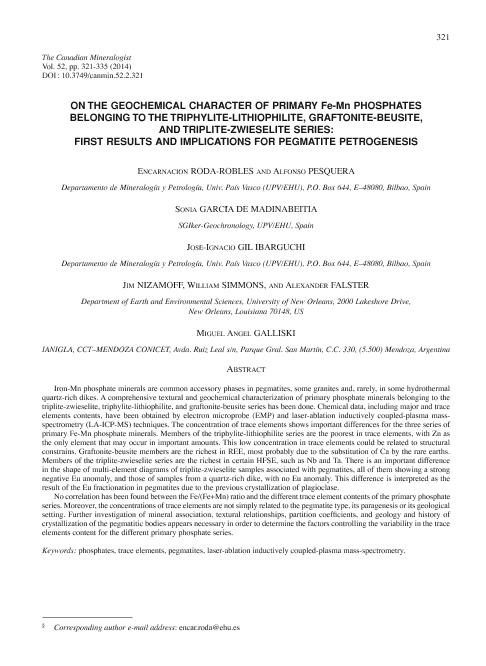Artículo
On the geochemical character of primary Fe-Mn phosphates belonging to the triphylite-lithiophilite, graftonite-beusite, and triplite-zwieselite series: first results and implications for pegmatite petrogenesis
Roda Robles, María Encarnacion; Pesquera, Alfonso; García de Madinabeitía, Sonia; Gil Ibarguchi, José Ignacio; Nizamoff, Jim; Simmons, William; Falster, Alexander; Galliski, Miguel Angel

Fecha de publicación:
06/2014
Editorial:
Mineralogical Association of Canada
Revista:
Canadian Mineralogist
ISSN:
0008-4476
e-ISSN:
1499-1276
Idioma:
Inglés
Tipo de recurso:
Artículo publicado
Clasificación temática:
Resumen
Iron-Mn phosphate minerals are common accessory phases in pegmatites, some granites and, rarely, in some hydrothermal quartz-rich dikes. A comprehensive textural and geochemical characterization of primary phosphate minerals belonging to the triplite-zwieselite, triphylite-lithiophilite, and graftonite-beusite series has been done. Chemical data, including major and trace elements contents, have been obtained by electron microprobe (EMP) and laser-ablation inductively coupled-plasma mass-spectrometry (LA-ICP-MS) techniques. The concentration of trace elements shows important differences for the three series of primary Fe-Mn phosphate minerals. Members of the triphylite-lithiophilite series are the poorest in trace elements, with Zn as the only element that may occur in important amounts. This low concentration in trace elements could be related to structural constrains. Graftonite-beusite members are the richest in REE, most probably due to the substitution of Ca by the rare earths. Members of the triplite-zwieselite series are the richest in certain HFSE, such as Nb and Ta. There is an important difference in the shape of multi-element diagrams of triplite-zwieselite samples associated with pegmatites, all of them showing a strong negative Eu anomaly, and those of samples from a quartz-rich dike, with no Eu anomaly. This difference is interpreted as the result of the Eu fractionation in pegmatites due to the previous crystallization of plagioclase. No correlation has been found between the Fe/(Fe+Mn) ratio and the different trace element contents of the primary phosphate series. Moreover, the concentrations of trace elements are not simply related to the pegmatite type, its paragenesis or its geological setting. Further investigation of mineral association, textural relationships, partition coefficients, and geology and history of crystallization of the pegmatitic bodies appears necessary in order to determine the factors controlling the variability in the trace elements content for the different primary phosphate series.
Palabras clave:
Phosphates
,
Trace Elements
,
Pegmatites
,
Laser Ablation
Archivos asociados
Licencia
Identificadores
Colecciones
Articulos(IANIGLA)
Articulos de INST. ARG. DE NIVOLOGIA, GLACIOLOGIA Y CS. AMBIENT
Articulos de INST. ARG. DE NIVOLOGIA, GLACIOLOGIA Y CS. AMBIENT
Citación
Galliski, Miguel Angel; Falster, Alexander; Simmons, William; Nizamoff, Jim; Gil Ibarguchi, José Ignacio; García de Madinabeitía, Sonia; et al.; On the geochemical character of primary Fe-Mn phosphates belonging to the triphylite-lithiophilite, graftonite-beusite, and triplite-zwieselite series: first results and implications for pegmatite petrogenesis; Mineralogical Association of Canada; Canadian Mineralogist; 52; 2; 6-2014; 321-335
Compartir
Altmétricas



